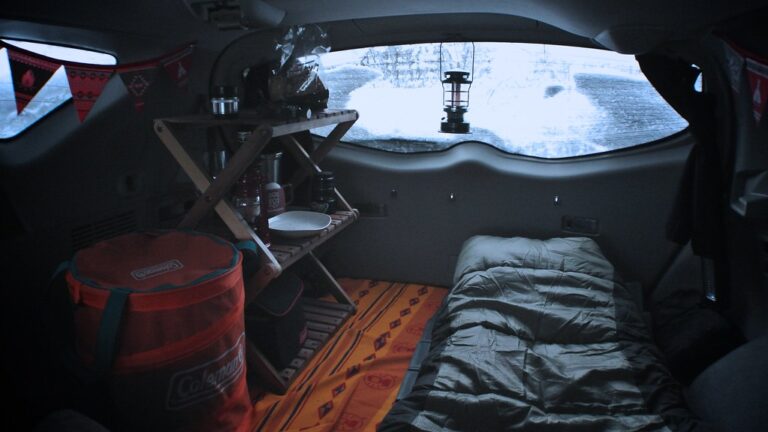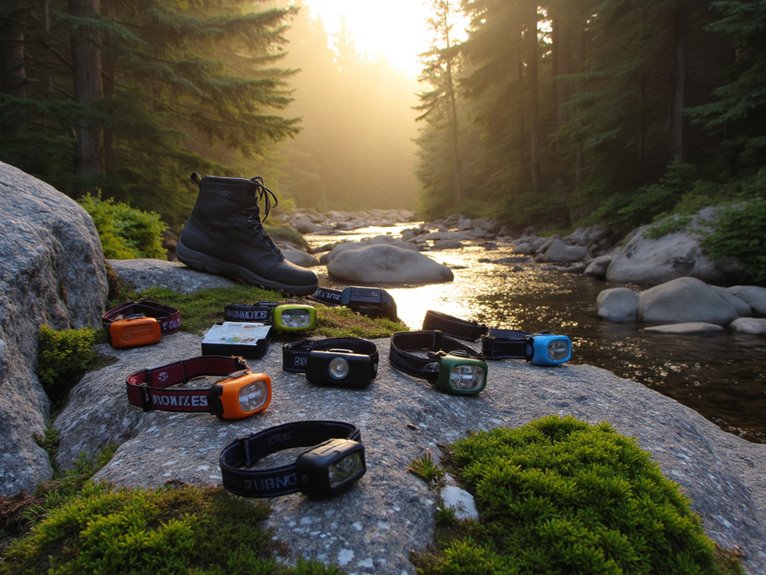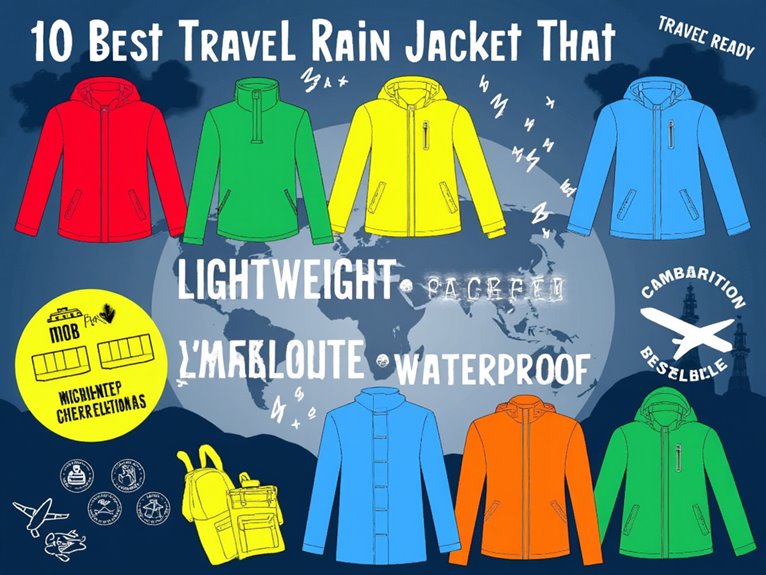Carbon Footprint of Outdoor Recreation: Gear Production and Travel
Your outdoor recreation carbon footprint comes primarily from two sources: travel to destinations generates about 90% of total emissions, with visitors averaging 479 kg CO2 per trip, while gear manufacturing accounts for roughly 64% of each product’s lifetime environmental impact. Air travel produces the highest emissions per mile, followed by personal vehicles, though staying local dramatically reduces your footprint. Gear durability matters considerably-extending a jacket’s lifespan from five to ten years cuts its annual carbon impact in half. Understanding these factors helps you make more sustainable choices.
We are supported by our audience. When you purchase through links on our site, we may earn an affiliate commission, at no extra cost for you. Learn more. Last update on 7th January 2026 / Images from Amazon Product Advertising API.
Notable Insights
- Travel accounts for 90% of outdoor recreation emissions, with air travel and cars generating the highest CO2 per passenger mile.
- Manufacturing represents 64% of outdoor gear’s carbon footprint, primarily from petroleum-based synthetic materials and energy-intensive production processes.
- Extending gear lifespan from five to ten years cuts annual carbon footprint in half, making durability crucial for sustainability.
- Electric vehicles offer the lowest carbon footprint for ground transportation, while local tourism significantly reduces overall travel emissions.
- Recycled materials and local manufacturing can substantially reduce gear production emissions compared to virgin synthetic materials and global supply chains.
Travel Dominates Recreation-Related Carbon Emissions
When you plan that dream hiking trip to a distant national park, you’re contributing to a carbon footprint that’s largely dominated by a single factor: getting there. Travel accounts for approximately 90% of total emissions from outdoor recreation visits.
Transportation to outdoor destinations creates nearly all recreation-related carbon emissions, making your journey choice the most critical environmental decision.
Air travel hits hardest, producing 2.4% of global energy-related CO2 emissions annually. At Yellowstone National Park, international flights comprise 72% of transit emissions despite only one-third of visitors flying.
Your vehicle choice matters considerably-planes and cars generate the highest CO2 per passenger mile compared to buses or trains.
Local tourism dramatically reduces these impacts. Park facilities contribute just 1% of total emissions, while accommodations add only 4%.
Carbon offsets become essential given travel’s overwhelming dominance in recreation-related emissions.
Understanding the Scale of Visitor Transportation Impact
While flights represent just one-third of park visits, they generate a staggering 72% of all transit emissions at destinations like Yellowstone National Park. This disparity reveals how visitor transportation creates vastly different carbon footprints depending on your travel mode.
The scale of these emissions is substantial:
- Transportation accounts for 90% of total tourism-related CO2 emissions at major parks
- Average visitors generate 479 kg CO2 each from travel alone
- Single parks like Gettysburg produce 2,540 metric tons annually from visitor transportation
Your choice of transportation dramatically affects carbon emissions. Cars dominate with over 1 million kg CO2 yearly at Gettysburg, while trucks generate the highest per capita emissions at 3.03 kg CO2 per trip.
Electric vehicles offer the lowest carbon footprint among ground transportation options.
On-Site Activities and Accommodation Emissions
Once you arrive at your destination, your carbon emissions don’t stop accumulating.
Your activities within park boundaries-from shuttle rides to visitor center visits-generate about 5% of your total trip emissions, while your overnight lodging contributes another 4%.
These on-site sources include within-park transportation, energy consumption from your hotel or lodge, and the operational emissions from facilities you’ll use during your stay.
Within-Park Transportation Impact
Although within-park transportation represents only 5% of total tourism-related CO2 emissions in major parks like Yellowstone, these on-site vehicle movements create substantial environmental impacts that you can directly influence through your travel choices.
Your visitor behavior determines transit emissions through three key factors:
- Vehicle selection – Cars and SUVs constitute 89% of vehicles in parks like Gettysburg, creating the majority of emissions.
- Transportation mode – Buses emit 524,701.5 kg CO2 annually despite comprising fewer vehicles than personal cars.
- Trip frequency – Multiple daily vehicle trips multiply your carbon footprint exponentially.
Alternative fuel vehicles reduce toxins by 90% compared to gasoline engines.
You’ll minimize impact by using park shuttle services, which eliminated 16.7 million passenger vehicle trips in 2018, preventing over 223 million emission-producing miles. When backpacking into remote areas, choosing ultralight sleeping bags under 2 pounds significantly reduces the fuel consumption required for gear transportation and resupply operations.
Lodging Energy Consumption
Every night you spend in park lodging consumes 85.7 thousand British thermal units per square foot, making accommodation facilities responsible for 9% of all commercial building energy use despite occupying just 7% of available floor space.
Water heating generates the highest energy intensity at 16.5 MBtu per square foot. Space heating follows closely, with both systems accounting for 20% of total lodging energy consumption.
Hotels produce 160-200 kg of CO2 per square meter annually. Global hotel emissions reached 55.7 million metric tons in 2001.
Your accommodation choices directly impact these figures through energy efficiency demands and sustainable practices adoption.
Recreation centers demonstrate even higher consumption at 470-514 kBtu per square foot, though recent renovations show significant reduction potential through improved efficiency measures.
Facility Operations Emissions
Beyond your accommodation’s energy demands, park facilities themselves generate substantial emissions through daily operations that directly impact your recreation experience.
Park operations excluding lodging contribute 6.05 kg CO2 per visitor through visitor centers, museums, shops, and restaurants. Gasoline-powered maintenance equipment like leaf blowers and trimmers create significant local VOC, PM, and CO2 emissions.
Key facility emission benchmarks include:
- On-site operations: 6.05 kg CO2 per visitor from daily facility functions
- Internal transit: 5% of total visitor emissions from park shuttles and buses
- Accommodation facilities: 28.95 kg CO2 per visitor for in-park hotels
Sustainability options are expanding rapidly. Mountain resorts target zero carbon emissions by 2030 through solar-powered lifts, wind power procurement, and electric equipment replacement.
These initiatives demonstrate measurable emission reductions while maintaining operational efficiency.
Manufacturing Impact of Outdoor Gear and Equipment

When you purchase outdoor gear, you’re contributing to manufacturing emissions that account for approximately 64% of a waterproof jacket’s total carbon footprint.
The extraction of raw materials like petroleum for synthetic fabrics generates significant CO2 emissions before manufacturing even begins.
Your gear’s environmental impact depends heavily on how long you use it-extending a product’s lifespan from five to ten years can cut its annual carbon footprint in half.
Choosing jackets with waterproof ratings of at least 10,000mm ensures you invest in durable gear that withstands serious hiking conditions for years.
Material Extraction Emissions
Manufacturing outdoor gear generates substantial carbon emissions long before you ever put on that jacket or lace up those boots.
Material sourcing creates the largest environmental impact in gear production, with extraction technologies requiring massive energy inputs to transform raw materials into usable fibers.
The primary emission sources from material extraction include:
- Polyester production – Processing fossil fuel feedstocks like ethylene and benzene accounts for 77% of direct manufacturing emissions.
- High-temperature processing – Converting petroleum into synthetic fibers requires fossil fuel-based heating systems that release substantial greenhouse gases.
- Chemical manufacturing – Producing primary chemicals like toluene, ammonia, and methanol generates significant carbon output during material sourcing.
These extraction processes occur upstream in your gear’s supply chain, making them harder to track but critically important for understanding total environmental impact.
Gear Lifespan Impact
While material extraction creates the initial carbon burden, your gear’s lifespan determines how many times you’ll trigger that manufacturing cycle throughout your outdoor pursuits. Gear durability directly impacts environmental costs-extending a jacket’s life from three to six years cuts manufacturing emissions per use in half.
| Gear Type | Average Lifespan | Manufacturing CO2 (kg) | Annual CO2 Impact | Durability Factor |
|---|---|---|---|---|
| Synthetic Jacket | 4 years | 45 | 11.25 | High |
| Hiking Boots | 3 years | 28 | 9.33 | Medium |
| Backpack | 8 years | 52 | 6.50 | Very High |
| Sleeping Bag | 6 years | 38 | 6.33 | High |
| Base Layer | 2 years | 12 | 6.00 | Low |
Consumer behavior drives replacement frequency more than actual wear. Patagonia’s repair programs demonstrate how maintenance extends lifespans while reducing cumulative carbon footprints. Modern backpacks featuring durable materials like 900D oxford fabric and ripstop nylon can significantly extend equipment lifespans when properly maintained.
Material Choices and Supply Chain Carbon Costs
Since outdoor gear depends heavily on synthetic materials and complex global supply chains, the carbon footprint of your equipment begins long before you reach the trailhead.
Polyester fabric production requires intensive fossil fuel processing, generating considerable emissions. Steel tent frames demand energy-intensive manufacturing that multiplies carbon costs.
Three key factors drive material-related emissions:
- Virgin synthetic production – Polyester and nylon creation relies on petroleum derivatives.
- Global transportation – Raw materials and finished products travel thousands of international miles.
- Manufacturing processes – Energy-intensive fabric treatment and component assembly.
Material sourcing decisions directly impact environmental outcomes.
Recycled plastics reduce carbon footprint compared to virgin materials. Local manufacturing cuts shipping emissions notably.
Carbon transparency through tools like the Higg Index enables better supply chain accounting and informed purchasing decisions.
Climate Change Effects on Recreation Participation Patterns
As global temperatures shift, the timing and location of your favorite outdoor activities are changing in measurable ways.
You’ll face a 23% decline in outdoor recreation days across the Southeast by 2100, while the Northwest gains 14% more suitable days. Your snow sports seasons are shrinking as temperatures rise 1-6°C, forcing earlier spring activities and extended summer periods.
Seasonal activity shifts require new climate adaptation strategies. You’ll need to adjust equipment choices and travel patterns as water sports extend into traditional shoulder seasons.
Beach recreation faces sea-level threats, while hiking encounters increased heat stress concerns. Your annual recreation spending could increase $3.2-15.6 billion nationally as participation patterns adapt.
Northern populations adopting southern climate responses could boost outdoor trips 17% additional at maximum warming scenarios.
Industry Sustainability Initiatives and Carbon Reduction Programs
Outdoor recreation companies are responding to these shifting participation patterns through extensive carbon reduction programs that target their operational footprints.
These collaborative initiatives demonstrate serious carbon accountability across the industry.
The European Outdoor Group’s Carbon Reduction Project exemplifies this approach. Their 2021 audit of 16 manufacturing facilities identified nearly 500 million kg of CO2 emissions, revealing critical hotspots for improvement.
Key industry sustainability strategies include:
- Emissions measurement tools – The Outdoor Industry Association partnered with Climate Neutral to provide members access to the Brand Emissions Estimator tool.
- Resort carbon neutrality goals – Big Sky Resort targets zero emissions by 2030 through energy efficiency improvements.
- Renewable energy adoption – Jackson Hole Mountain Resort sources all electricity from nearby wind farms.
These programs follow five-stage processes: supplier mapping, emission measurement, hotspot identification, planning, and implementation action.
Economic Benefits Versus Environmental Trade-offs
While the outdoor recreation sector generated $1.2 trillion in economic output during 2023, this remarkable growth comes at a substantial environmental cost that challenges the industry’s long-term sustainability.
The sector supports 5 million jobs and represents 3.1% of total U.S. employment. Economic growth consistently outpaces national GDP expansion, with 2023 showing 3.6% growth versus 2.9% nationally.
However, you’re contributing to significant carbon emissions through your participation. Travel to destinations like Yellowstone generates over one megaton of CO2 annually, averaging 479 kg per visitor.
Your gear purchases add carbon-intensive manufacturing impacts through global supply chains. Popular equipment like portable camping stoves requires energy-intensive production of materials such as iron and aluminum components before reaching outdoor enthusiasts.
This creates a fundamental tension between economic benefits and environmental costs. Gateway communities depend on recreation revenue, yet rising visitor numbers escalate greenhouse gas emissions.
Implementing sustainable practices becomes essential for balancing economic growth with environmental responsibility.
Strategies for Lower-Carbon Outdoor Recreation Choices
Since transportation accounts for 75% of outdoor recreation’s carbon emissions, selecting sustainable gear and minimizing travel distance represent your most effective strategies for reducing environmental impact.
Choose sustainable gear made from renewable materials like recycled polyester or organic cotton. Support brands that disclose manufacturing emissions and use environmentally responsible processes. You’ll reduce production-related carbon output while maintaining equipment performance standards.
Implement these core strategies:
- Local Recreation Selection – Choose destinations within 50 miles to cut travel emissions by 60-80%
- Group Activities Coordination – Carpool with 3-4 people to reduce per-person transportation impact
- Waste Reduction Systems – Pack reusable containers and avoid single-use plastics
Support conservation efforts through trail stewardship programs and eco friendly practices.
Consider carbon offsets for unavoidable long-distance trips, though direct emission reduction remains more effective than offsetting programs.
When selecting hiking jackets, prioritize lightweight designs under 7 ounces that offer packability without sacrificing waterproof performance, reducing both gear weight and manufacturing material usage.
Frequently Asked Questions
How Do Electric Vehicles Reduce Carbon Emissions for Park Visits?
Electric vehicles eliminate tailpipe emissions during your park visits, producing zero direct CO2 output.
You’ll reduce lifetime emissions by approximately 50% compared to gasoline cars, even accounting for battery manufacturing impacts.
When you charge using renewable energy through expanding charging infrastructure, you achieve near-zero carbon travel.
EVs maintain superior efficiency throughout their operational lifetime, ensuring consistently lower emissions for your frequent outdoor adventures.
What Certification Programs Help Identify Low-Carbon Outdoor Gear Brands?
You can identify eco friendly brands through several sustainable certifications.
B Corp certification requires companies to meet rigorous environmental and social standards with public reporting.
Bluesign Approved confirms toxic-free textile manufacturing with reduced emissions.
Climate Neutral Certified verifies brands achieve net-zero carbon emissions through measurement, reduction, and offsetting.
GOTS and OEKO-TEX certifications guarantee organic fibers and chemical-free production processes.
Can Carbon Offset Programs Effectively Neutralize Recreation-Related Emissions?
You’ll find carbon offset programs show mixed results for neutralizing emissions.
Carbon credits from forest protection projects can reduce deforestation by 47-75% in some areas.
However, studies indicate only 12% of offset projects deliver real emission reductions due to overestimated benefits and additionality issues.
Permanency poses another challenge-stored carbon may release through wildfires.
You should use offsets as part of holistic sustainability plans, not standalone solutions.
How Do Group Trips Compare to Solo Travel for Carbon Efficiency?
Group trips greatly outperform solo travel for carbon efficiency through strategic sharing resources and optimized group dynamics.
You’ll reduce per-person emissions by 50-70% when carpooling with three or more people versus driving alone.
Flying solo generates 0.62 tons CO2 cross-country, while group car travel splits 1.26 tons among passengers.
You achieve maximum efficiency combining fuel-efficient vehicles with shared accommodations and consolidated gear transportation.
What Role Do Local Outdoor Recreation Options Play in Reducing Emissions?
Local access to outdoor recreation dramatically cuts your carbon emissions by eliminating long-distance travel.
You’ll reduce vehicle fuel consumption by 60-80% when choosing nearby trails over destination trips.
Community engagement strengthens when you support local parks and facilities, creating economic incentives for sustainable infrastructure.
Your frequent use of neighborhood outdoor spaces builds conservation awareness while promoting active transportation like biking and walking to trailheads.
On a final note
You can notably reduce your recreation carbon footprint through strategic choices. Transportation generates 70-85% of outdoor activity emissions, so you’ll cut impact most by choosing local destinations, carpooling, or using public transit. Your gear purchases matter less but still count-buy quality items that last, choose used equipment, and select brands with verified carbon reduction programs. Small changes in how you travel and what you buy create measurable environmental benefits.




